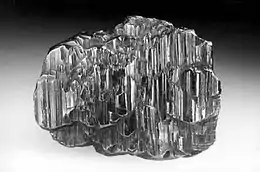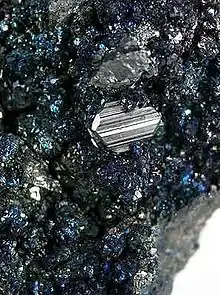Andorite
Andorite is a sulfosalt mineral with the chemical formula PbAgSb3S6.
| Andorite | |
|---|---|
 Andorite - Itos Mine, Oruro City, Cercado Province, Bolivia. Specimen height is 4.1 cm. | |
| General | |
| Category | Sulfosalt mineral |
| Formula (repeating unit) | PbAgSb3S6 |
| Strunz classification | 2.JB.40a |
| Crystal system | Orthorhombic |
| Crystal class | Pyramidal (mm2) H-M symbol: (mm2) |
| Space group | Pn21a (andorite VI, senandorite) |
| Unit cell | a = 12.99, b = 19.14, c = 4.3 [Å]; Z = 4 |
| Identification | |
| Color | Dark steel-gray, may tarnish yellow or iridescent; white in polished section |
| Crystal habit | Crystals stout prismatic to tabular on {100}, striations parallel to [001]; massive |
| Twinning | On {110} |
| Cleavage | none observed |
| Fracture | conchoidal |
| Mohs scale hardness | 3 - 3.5 |
| Luster | metallic |
| Streak | Black |
| Diaphaneity | Opaque |
| Specific gravity | 5.33 - 5.37 |
| Optical properties | anisotropic |
| References | [1][2] |
It was first described in 1892 for an occurrence in the Baia Sprie mine, Baia Sprie, Maramures County, Romania, and named for Hungarian amateur mineralogist Andor von Semsey (1833–1923).[1][3] Andorite occurs in low-temperature polymetallic hydrothermal veins. It occurs associated with stibnite, sphalerite, baryte, fluorite, siderite, cassiterite, arsenopyrite, stannite, zinkenite, tetrahedrite, pyrite, alunite, quartz, pyrargyrite, stephanite and rhodochrosite.[2]
References
- "Andorite: Mindat mineral information and data". 2010. Archived from the original on 21 January 2010. Retrieved 5 February 2010.
- Handbook of Mineralogy
- "Andorite Mineral Data". 2010. Archived from the original on 17 January 2010. Retrieved 5 February 2010.

Sharp crystals of andorite (to 7 mm) with stannite matrix, San José Mine, Oruro Department, Bolivia
| Wikimedia Commons has media related to Andorite. |
This article is issued from Wikipedia. The text is licensed under Creative Commons - Attribution - Sharealike. Additional terms may apply for the media files.